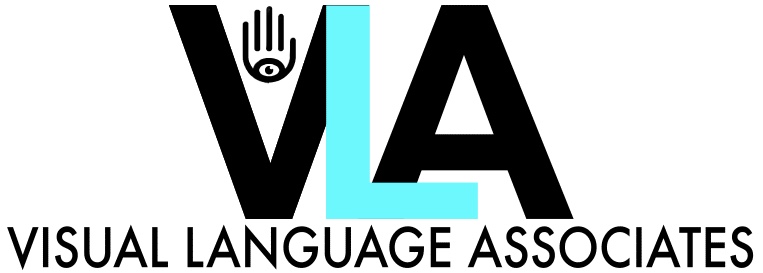Through our consultants, researchers, clinicians, interpreters, transliterators and programs, VLA aims to apply evidence-based research to advancing the right and opportunity for those who are deaf or hard-of-hearing to access, process, acquire, and use visual language.
American Sign Language
American Sign Language (ASL) is one of many traditionally visual languages used throughout the world. A combination of handshape, hand location, palm orientation, hand movements, and non-manual information comprise signs that convey the lexicon and grammar of visual ASL. But ASL is not restricted to the visual mode. Via what is called Tactile ASL, the lexicon and grammar of traditionally visual ASL can be conveyed entirely in the haptic mode as well.
Thus, signed and tactile ASL share linguistic structures without sharing the mode via which those structures are conveyed.
As is true of all languages:
• ASL is formed via an assemblage of smaller parts, meaningless, in and of themselves. Where ASL is concerned, these fundamental structural elements — handshape and hand location in space, combined in a series of movements and holds (Liddel and Johnson) — comprise the signs, or vocabulary, of ASL. The smallest manipulable parts of a language are traditionally referred to as its phonology. (Stokoe coined the term cherology to refer to signed language structures serving the same linguistic function as phonology.)
• ASL users agree on the rules for manipulating these parts and well as the meaning of its vocabulary. The smallest meaningful parts of a language are traditionally referred to as its morphology.
• The vocabulary is assembled into sentences, following a set of rules also agreed upon by ASL users. These rules are traditionally known as the syntax of the language.
• Sentences are combined to convey complex ideas, both implied and overt. The purpose for expressing these ideas is considered the pragmatics of language.
• Native ASL users acquire and express this hierarchy of linguistic structures (i.e. phonology/cherology, morphology, syntax, and pragmatics) through consistent exposure to native language models. Such exposure provides for passive language acquisition and the acquisition of native language use.
interpreting
Add your answer here. Ad litora torquent per conubia nostra, per inceptos himenaeos. In efficitur malesuada nibh ut sagittis. Vestibulum pulvinar at risus at pretium. Mauris gravida nibh consectetur augue feugiat mollis. In sollicitudin tellus nec purus faucibus, a viverra neque elementum. Cum sociis natoque penatibus et magnis dis parturient montes, nascetur ridiculus mus.
language.
Add your answer here. Proin suscipit vel nulla in tincidunt. Fusce sit amet massa turpis. Donec lectus elit, egestas nec ultricies nec, elementum non odio. Curabitur porttitor auctor diam auctor sagittis. Aenean nibh est, tristique vitae tortor ut.
Your Vision…
…Our know how
Where Deaf and Hearing people come together, we are your language access link. Our Deaf and Hearing team of American Sign Language (ASL) — Cued American English (CAE) bilingual linguists, interpreters, and transliterators specialize in visual language access, acquisition, and use.

